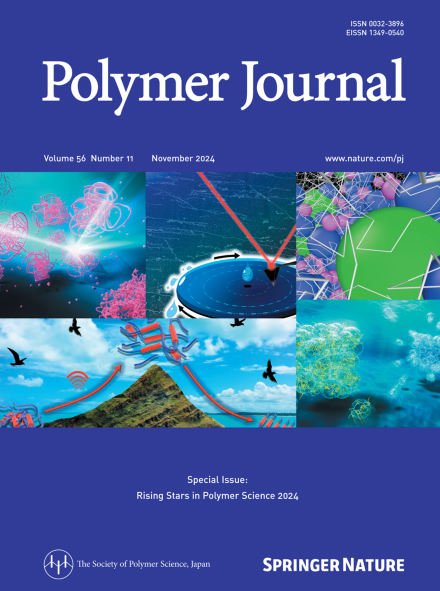通过不均匀性的各个方面来理解玻璃体的性质
IF 2.3
4区 化学
Q3 POLYMER SCIENCE
引用次数: 0
摘要
Vitrimers是一类独特的交联材料,其特点是在其聚合物网络结构中具有结合键交换机制。这种键交换促进了网络链在适当刺激(通常是热)下的扩散,从而实现了特定的玻璃体特性,如应力松弛和蠕变。最近的综述广泛地记录了通过这种键交换性质实现的各种分子设计和有价值的可持续功能。许多基础研究都集中在开发玻璃聚合物性质的调谐方法上,利用具有均匀分布的键交换单元的均匀网络结构的模型玻璃聚合物。相比之下,一些研究小组目前故意设计了不均匀的网络结构,其特点是高度局部化的键交换单元和永久交联所施加的限制。在这篇综述中,我们强调了非均匀网络系统的重要性,作为多功能调整玻璃聚合物性质的潜在途径,这可能有助于更深入地了解这些材料。Vitrimers是一种交联材料,具有结合键交换机制,允许网络链在响应热等刺激时扩散,从而产生应力松弛和蠕变等特性。虽然许多研究都集中在使用具有均相结构的模型系统来调整聚合物的性质,但一些研究人员已经设计出具有局部键交换单元和永久交联约束的非均相网络。本文综述了非均匀网络结构对高分子材料性能广泛设计的重要意义。本文章由计算机程序翻译,如有差异,请以英文原文为准。

Understanding vitrimer properties through various aspects of inhomogeneity
Vitrimers represent a unique class of cross-linked materials characterized by an associative bond exchange mechanism within their polymeric network structure. This bond exchange facilitates the diffusion of network chains upon the application of suitable stimuli, typically heat, thus enabling specific vitrimer properties such as stress relaxation and creep. Recent reviews have extensively documented the diverse molecular designs and valuable sustainable functionalities achieved through this nature of bond exchange. Numerous fundamental studies have focused on developing tuning methods for vitrimer properties, utilizing model vitrimers that assume homogeneous network structures with uniformly distributed bond exchange units. In contrast, some research groups currently have deliberately engineered inhomogeneous network structures, characterized by highly localized bond exchangeable units and the presence of constraints imposed by permanent cross-links. In this review, we emphasize the significance of inhomogeneous network systems as potential avenues for the versatile tuning of vitrimer properties, which could contribute to a deeper understanding of these materials. Vitrimers are cross-linked materials featuring an associative bond exchange mechanism that allows network chain diffusion in response to stimuli like heat, leading to properties such as stress relaxation and creep. While numerous studies focus on tuning vitrimer properties using model systems with homogeneous structures, some researchers have engineered inhomogeneous networks with localized bond exchange units and constraints from permanent cross-links. This review highlights the significance of inhomogeneous network structures for broad designing of vitrimer properties.
求助全文
通过发布文献求助,成功后即可免费获取论文全文。
去求助
来源期刊

Polymer Journal
化学-高分子科学
CiteScore
5.60
自引率
7.10%
发文量
131
审稿时长
2.5 months
期刊介绍:
Polymer Journal promotes research from all aspects of polymer science from anywhere in the world and aims to provide an integrated platform for scientific communication that assists the advancement of polymer science and related fields. The journal publishes Original Articles, Notes, Short Communications and Reviews.
Subject areas and topics of particular interest within the journal''s scope include, but are not limited to, those listed below:
Polymer synthesis and reactions
Polymer structures
Physical properties of polymers
Polymer surface and interfaces
Functional polymers
Supramolecular polymers
Self-assembled materials
Biopolymers and bio-related polymer materials
Polymer engineering.
 求助内容:
求助内容: 应助结果提醒方式:
应助结果提醒方式:


